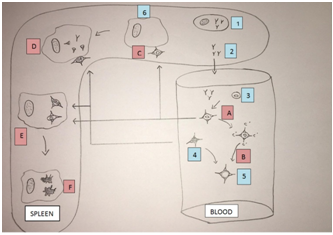|
Size: 1809
Comment:
|
Size: 1811
Comment:
|
| Deletions are marked like this. | Additions are marked like this. |
| Line 10: | Line 10: |
| {{attachment:image.png|pop-up text}} < >'''Fig 1.'''< >''1 – Lymphocyte, 2 - Free Antibodies, 3 – Erythrocyte, 4 – Spherocyte, 5 – Ghost Erythrocyte, 6 – Macrophage A – Complement reaction, B – Intravascular haemolysis, C – Attachment to macrophage, D – Partial phagocytosis, E – Erythrophagocytosis, F – Extravascular haemolysis. '' | {{attachment:image.png|pop-up text}} < >'''Fig 1.'''< >''1 – Lymphocyte, 2 - Free Antibodies, 3 – Erythrocyte, 4 – Spherocyte, 5 – Ghost Erythrocyte, 6 – Macrophage A – Complement reaction, B – Intravascular haemolysis, C – Attachment to macrophage, D – Partial phagocytosis, E – Erythrophagocytosis, F – Extravascular haemolysis. '' |
Itt írjon a(z) ImmunhemolyticAnemia-ról/ről
Introduction
Paul Ehrlich in the beginning of the 20th Century proposed the idea of “horror autotoxicus”. This idea suggested that any biological organism is able to endure and recognise its own tissue. However, had the above system become intolerant, an autoimmune disease would be caused. In the following passage the definition of Immune Mediated Haemolytic Anaemia will be discussed in depth. Following, its causes will be detailed using data retrieved from various scientific articles and specialisation books. Moreover, the symptoms presented in the disease will be stated, that one along with the diagnostic methods and tests can use to identify the disease. Lastly, the treatments available and their effectiveness will be mentioned, using proof from the findings collected from the aforementioned sources.
What is Immune Mediated Haemolytic Anaemia
Immune anaemia is caused due to antibody adherence to the cell membrane of a red blood cell which may or may not have a complement fixation. This interaction causes the red blood cell to become spherical which reduces their lifespan by either causing their lysis by the monocytes and phagocytes of the body’s immune system or when the cell membrane forms a complement with the immunoglobulins and an attack complex is created which causes intravascular haemolysis. (Fig. 1)
 < >Fig 1.< >1 – Lymphocyte, 2 - Free Antibodies, 3 – Erythrocyte, 4 – Spherocyte, 5 – Ghost Erythrocyte, 6 – Macrophage A – Complement reaction, B – Intravascular haemolysis, C – Attachment to macrophage, D – Partial phagocytosis, E – Erythrophagocytosis, F – Extravascular haemolysis.
< >Fig 1.< >1 – Lymphocyte, 2 - Free Antibodies, 3 – Erythrocyte, 4 – Spherocyte, 5 – Ghost Erythrocyte, 6 – Macrophage A – Complement reaction, B – Intravascular haemolysis, C – Attachment to macrophage, D – Partial phagocytosis, E – Erythrophagocytosis, F – Extravascular haemolysis.
